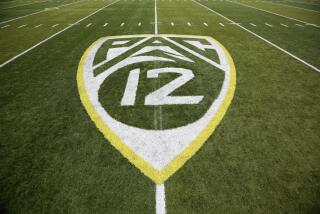A Tycoon With a Gift for Generosity
- Share via
If tycoon Daniel Murphy is recalled at all, it is for his single namesake, a highly regarded high school for Catholic boys in the Mid-Wilshire district.
But in his day, the railroad-oilman was the city’s richest and most powerful man, the creator of company towns in Needles, Calif., Colton and El Segundo.
Even today, although few recognize his name, the foundation he established remains the largest single benefactor of the Los Angeles Roman Catholic Archdiocese, contributing hundreds of millions of dollars over the years, including $25 million for the new downtown cathedral.
Born in 1855 in Hazelton, Pa., Murphy spent his early years in the Oklahoma oil fields before coming to California as an employee of the Southern Pacific railroad.
Taking advantage of cheap land and open space, in 1883 Murphy and his Irish-born partner, Frank Monaghan, began transforming the Needles railroad station (named for a mountain range in Arizona) into a town.
*
In the scorched desert, they built a general store, bank and utility plants for a population of 300 railroad men. Within a decade, they launched what would become a business empire by securing another foundation of California fortunes--water rights--and setting up a chain of refrigeration and ice manufacturing plants for the Santa Fe railroad.
As refrigerated freight cars chugged across the desert carrying fresh citrus from Los Angeles to the East, they stopped in Needles and other spots along the way to replenish their blocks of ice.
After investing some of his profits in gold and silver mines along the Colorado River, Murphy decided to expand his empire by moving to Los Angeles, leaving his brother, Thomas, and Monaghan in charge of business in Needles.
In 1894, at the urging of a friend, Murphy provided financial backing for the 3-year-old California Portland Cement Co., in the desert east of Los Angeles, in Colton. He patched up the crumbling cement company, serving as its president for 35 years.
*
Before the turn of the century, while running the cement company, Murphy was again smitten with oil fever. Buying land in the Coyote Hills above Fullerton and in East Whittier, he opened the Brea Canyon Oil Co.
With his Midas touch and wildcatting background, the oil-soaked adventurer hit gushers that swelled his company’s profits. More than a decade later, he would pitch a tent on the El Segundo sand dunes surrounding the Standard Oil refinery, helping to create another company town.
In 1906, as his wells flowed, Murphy and his wife, Antoinette, moved into their new home at 2076 W. Adams Blvd.--the city’s first Italian Renaissance-style house. Murphy bought the adjoining property, which belonged to former Los Angeles Mayor Cameron Thom, tore down the house and extended his garden.
From his Los Angeles office, Murphy began promoting cement sales, luring members of the influential Southern California Chapter of the American Institute of Architects to the feisty blue-collar community of Colton. There, the tycoon’s guests were wined and dined before viewing a demonstration on the manufacturing and testing of cement.
This eventually laid the groundwork for even larger public events, recorded with headlines such as: “Great Barbecue Acquaints People With Industry” and “Feast Cements Valley Fellowship.” More than 3,500 picnickers sat at the foot of Mt. Slover--named for trapper Isaac Slover, who lived and died on the limestone mountain--surrounded by massive kilns, sampling the free food and watching demonstrations of Murphy’s product.
Laying a firm foundation in cities across Southern California, Murphy’s cement helped build Southwestern monuments, ranging from Union Station in Los Angeles to Hoover Dam and the All American Canal.
Tired and overworked, Murphy and his wife headed for Europe for a vacation and to adopt a son. But as they were leaving an orphanage in Italy, a 7-year-old girl named Bernardine tugged at Antoinette’s dress. Believing it was a sign from God, the Murphys took the girl home, adopting her into vast wealth.
*
It was not an isolated act of compassion, for Murphy’s generosity flowed like one of his oil wells. In 1931, eight years before Murphy died, Pope Pius XI recognized that by bestowing on him the title of Commander of the Equestrian Order of the Holy Sepulcher.
“Murphy made the recipient of his bounty doubly happy because he always gave with pleasure and not with reluctance,” Bishop John J. Cantwell once noted.
After Bernardine’s adoptive parents died, she continued to live in the mansion, eventually meeting Daniel Donahue, who was working as a brother in the St. John of God Nursing Home across the street.
When one of Bernardine’s servants became ill and wanted to die in his native Germany, Donahue volunteered to take him there. Later Donahue and Bernardine met again in Rome and a romance blossomed.
Released from his religious vows by Pope Pius XII, Donahue married Bernardine in January 1954.
*
Because of the gifts she, like her parents, lavished on the Roman Catholic church, schools and hospitals, Pope John XXIII made Bernardine a papal countess in 1960. She was the last woman in Southern California to receive such an honor.
In 1966, two years before Bernardine’s death, the archdiocese renamed St. John Vianney High School in Los Angeles for her father.
Today, Daniel Murphy High School is best known as an educator of promising African American and Latino young men, an unusual number of whom go on to pursue careers in public service. Among the visible Daniel Murphy graduates today are Los Angeles Police Chief Bernard C. Parks and city Fire Chief William R. Bamattre.
Cecilia Rasmussen’s new book, “L.A. Unconventional,” a collection of stories about Los Angeles’ unique and offbeat characters, will be published in October. To order call (800) 246-4042. The special price of $30.95 includes shipping and sales tax.
More to Read
Sign up for Essential California
The most important California stories and recommendations in your inbox every morning.
You may occasionally receive promotional content from the Los Angeles Times.













